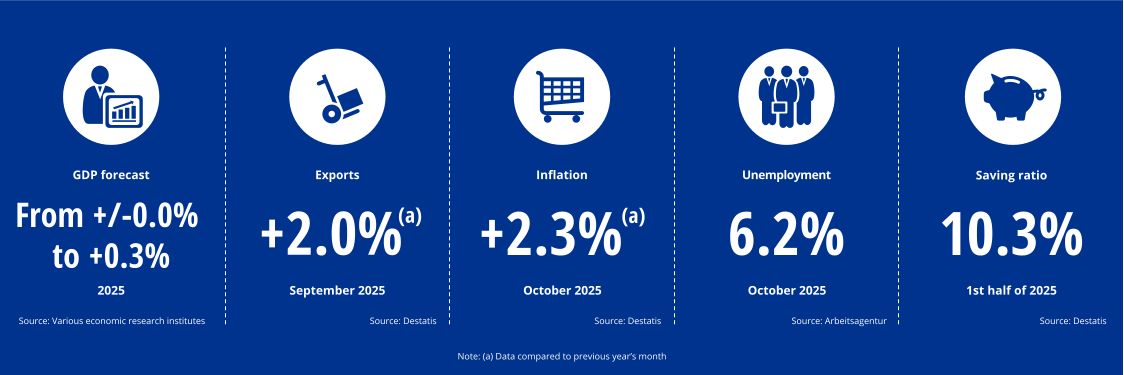With a gross domestic product of €4,305 billion in 2024, Germany is the world's third-largest economy after the United States and China and just ahead of Japan, making it the largest economy in Europe. However, India is expected to overtake Japan and Germany in the future. Exports of motor vehicles and motor vehicle parts, as well as chemical products, in particular, have made Germany the world's third-largest export nation to date. At 70%, the service sector contributes the largest share to the country's gross domestic product (GDP).

Data retrieved: 7 November 2025

German economy stagnates in the third quarter of 2025
According to preliminary calculations by the Federal Statistical Office, gross domestic product (GDP) stagnated in the third quarter of this year compared to the previous quarter. While the first quarter still recorded a slight increase of +0.3%, economic output declined slightly by -0.2% in the second quarter according to revised figures, before remaining at +/- 0.0% in the following months from July to September 2025. This meant that a technical recession was narrowly avoided in the third quarter – according to experts, this occurs when GDP shrinks for two consecutive quarters.
The German economy is currently under considerable pressure: demand in key industries such as the automotive and chemical sectors is weak, and additional burdens are being created by the new US tariffs introduced in 2025, which are hampering exports of German products to the US. Added to this are rising energy costs and the lack of momentum from the reforms that have been announced but not yet implemented.
Consumer spending is also subdued, as evidenced by the persistently high savings rate (see last section). Many people are spending less money due to uncertain expectations for the future and significantly higher prices for everyday goods such as food since the pandemic.
Although some economic experts are placing their hopes in the German government's fiscal policy package, they also warn that it could only provide short-term stimulus. It would not replace the urgently needed structural reforms.
By contrast, sentiment among companies in Germany has improved slightly. The ifo Business Climate Index rose to 88.4 points in October 2025, up from 87.7 points in September. This was due to improved expectations for the coming months. However, the current business situation was assessed as slightly worse.
The public expenditure ratio, which indicates the state's influence on an economy, is calculated as total government expenditure as a percentage of GDP. According to the International Monetary Fund (IMF), this amounted to 49.5% in Germany in 2024, which was above the average for the G7 countries of 46.1% and the public spending ratio of other major economies such as the United Kingdom (44.0%), the United States (37.6%), and China (32.9%).
According to the OECD, the share of taxes and social security contributions in total labor costs for average earners in Germany was 47.9% in 2024 for singles without children. This puts Germany in second-worst place among the 38 OECD member states after Belgium and well above the OECD average of 34.9%, which detracts from Germany's attractiveness as an investment location. The rate is also significantly lower in countries outside the EU, such as the United Kingdom (29.4%) and the United States (30.1%).
The latest forecasts by German economic research institutes and government organizations for GDP growth in Germany range between +/-0.0% and +0.3% for the 2025 calendar year and between +0.7% and +1.7% for the 2026 calendar year.

Data retrieved: 7 November 2025
The KPMG Global Navigator offers insights into global growth prospects, opportunities, and challenges.
Our CEO Outlook 2025, for which 1,350 CEOs of large companies around the world were surveyed, including 125 CEOs in Germany, also provides assessments of the economic situation, generative AI, ESG, and other current topics.
Our Future Readiness Monitor 2025, for which 570 top decision-makers in the German economy were surveyed, also provides an assessment of German companies with regard to their own future viability in the face of new opportunities and complex tasks, their investment plans, and their assessment of trends in the coming years.

German exports and imports rise in September 2025
German exports rose in September 2025, partly due to demand from the US picking up for the first time in months. They grew by +1.4% compared to the previous month of August 2025 to €131.1 billion. Compared to September 2024, exports even increased by +2.0%.
Conversely, goods worth €115.9 billion were imported – an increase of +3.1% compared to the previous month of August 2025. The foreign trade balance thus closed with a surplus of €15.3 billion.
Most exports in September 2025 were once again destined for the US. German goods worth €12.2 billion were delivered there, an increase of +11.9% compared to August. This means that exports to the US rose again for the first time compared to the previous month after five consecutive declines. Compared with September 2024, however, exports to the world's largest economy were still down by 14.0%. Overall, exports to the US accounted for 9.6% of total German exports in the period up to September 2025, compared with 10.5% in the same period of the previous year.
Real (price-adjusted) order intake in the manufacturing sector rose by +1.1% in September 2025 compared with August 2025, adjusted for seasonal and calendar effects. Excluding large orders, order intake was +1.9% higher than in the previous month. In the less volatile three-month comparison, incoming orders in the third quarter of 2025 were down 3.0% compared with the second quarter.
A similar picture emerges in industrial production: real (price-adjusted) production in the manufacturing sector rose by 1.3% in September 2025 compared with August 2025, adjusted for seasonal and calendar effects. In the less volatile three-month comparison, production in the third quarter of 2025 was 0.8% lower than in the second quarter.

Inflation falls slightly again in October 2025
Inflation in Germany has slowed down again slightly. Goods and services rose in price by an average of +2.3% compared with the same month last year.
Consumers recently benefited from cheaper energy, paying 0.9% less in October than a year earlier. Services rose by an average of 3.5%, while food prices rose by 1.3%.
The core inflation rate, i.e., the inflation rate excluding the often highly volatile energy and food prices, was 2.8% in October 2025, as in the previous month. This means that it has hardly changed in a year and a half—a strong indication of persistently high price pressure.
The European Central Bank has lowered its key interest rate eight times since last year, but has paused since July 2025.
The current forecasts by German economic research institutes and government organizations on the development of the inflation rate in Germany indicate that the annual average for 2025 will be slightly lower than the current level. For the calendar year 2025, projections range between +2.0% and +2.4%:

Data retrieved: 7 November 2025

Number of unemployed fell only slightly in October 2025
The number of unemployed people in Germany fell by 44,000 to 2.911 million in October 2025 compared to September 2025. That is 120,000 more than in October 2024. The unemployment rate fell by -0.1 points to 6.2% compared to September 2025, but rose by +0.2 points compared to the previous year.
Structural challenges continue to have a noticeable dampening effect on the labor market. The necessary impetus for a stronger recovery is still lacking. Employment growth remains weak, and demand for new employees is low. The situation on the training market is also tense. The proportion of applicants who receive a training place is at its lowest level in 25 years. While the number of applicants has risen, the number of apprenticeships on offer has fallen due to the economic downturn.
German households are saving slightly less than in the previous year
Private households in Germany saved an average of 10.3% of their disposable income in the first half of 2025. This means that, on average, people saved around €10.30 per €100 of income, which corresponds to just under €270 per month per person.
In the same period last year, the savings rate was 11.1%. The current figure is therefore still roughly in line with the average since 2000. Many respondents to surveys say they are currently unable to save as much because the cost of daily expenses such as food has risen.
In an international comparison, Germany continues to be one of the countries with the highest savings rates. The gross savings rate, which also takes depreciation into account, was 20% in 2024, well above the EU average of 14.6%.
Further interesting content for you
Your contacts
Stay up to date with what matters to you
Gain access to personalized content based on your interests by signing up today
Andreas Glunz
Managing Partner International Business
KPMG AG Wirtschaftsprüfungsgesellschaft
Joachim von Prittwitz
Markets, International Business
KPMG AG Wirtschaftsprüfungsgesellschaft
Connect with us
- Find office locations kpmg.findOfficeLocations
- kpmg.emailUs
- Social media @ KPMG kpmg.socialMedia





